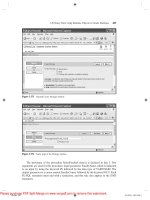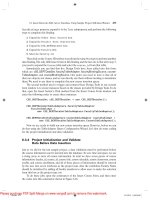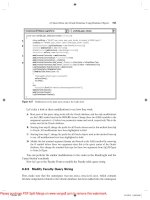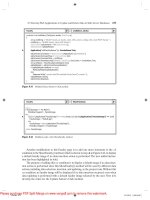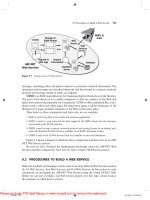Sams Teach Yourself Database Programming with Visual C++ 6 in 21 Days phần 10 potx
Bạn đang xem bản rút gọn của tài liệu. Xem và tải ngay bản đầy đủ của tài liệu tại đây (1.63 MB, 39 trang )
The ISQLErrorInfo Interface
The final error-related interface covered today is the ISQLErrorInfo interface. This interface is used in the custom error
object pointer of an error record. You access the ISQLErrorInfo interface by using the GetCustomErrorObject
method of the IErrorRecord interface. The ISQLErrorInfo interface defines a single method: GetSQLInfo. This
method is defined as follows:
HRESULT GetSQLInfo(BSTR *pSQLStateStr, LONG *plSQLErrorNum);
The pSQLStateStr parameter returns a string containing the current SQL state. The plSQLErrorNum returns the
provider-specific SQL error number. The pSqlStateStr is an [out] bstr, so the caller must free it by using
SysFreeString.
The Completed DispErrorInfo Source Code
Armed with the information provided by these error interfaces, you are ready to return to the DispErrorInfo procedure in
Listing 21.2. The final procedure accesses the IErrorRecord interface and loops through each available error record, one
at a time. DispErrorInfo retrieves an IErrorInfo interface for each error record and uses that IErrorInfo interface
to access the error description, source, and GUID. The GetCustomErrorObject is accessed for each record. If a
ISQLErrorInfo interface is available, the current SQL state and error number are also displayed. The complete
DispErrorInfo procedure appears in Listing 21.3.
NOTE
Remember to use the SysFreeString method to release the returned string memory. The
BSTR type is a Unicode type string. (Refer to Day 19, "Navigating the Result of a Query,"
for more information about the methods available to process Unicode strings.)
Listing 21.3 The Completed DISPERRORINFO Procedure
1: HRESULT DispErrorInfo(IUnknown *pErrorInt, GUID ErrorIID) {
2: ISupportErrorInfo *pSupportErrorInfo;
3: IErrorInfo *pErrorInfo,
4: *pErrorInfoRecord;
5: IErrorRecords *pErrorRecords;
6: ISQLErrorInfo *pSQLErrorInfo;
7: BSTR pDescription = NULL;
8: BSTR pSource = NULL;
9: BSTR pSQLState = NULL;
10: GUID ErrorGUID;
11: ULONG i,
12: lNumRecs;
13: LONG lSQLErrorNum;
14: HRESULT retcode = S_OK;
15:
16: // Obtain Access to the ISupportErrorInfo Interface
17: if(SUCCEEDED(pErrorInt->QueryInterface(IID_ISupportErrorInfo,
18: (void **) &pSupportErrorInfo))) {
19: // Check if Extended Error Information is Available
20: if(SUCCEEDED(pSupportErrorInfo->InterfaceSupportsErrorInfo
(ErrorIID))) {
Teach Yourself Database Programming with Visual C++ 6 in 21 days Day 21-OLE DB Error Handling
(7 of 15) [9/22/1999 1:48:06 AM]
Simpo PDF Merge and Split Unregistered Version -
21: // Access the Error Info interface
22: if(SUCCEEDED(GetErrorInfo(0,&pErrorInfo))) {
23: // Retrieve the Error Records Interface
24: if(SUCCEEDED(pErrorInfo->QueryInterface(IID_IErrorRecords,
25: (void **) &pErrorRecords))) {
26: // Retrieve the Number of Error Records
27: if(SUCCEEDED(pErrorRecords->GetRecordCount(&lNumRecs))) {
28: for(i=0; i < lNumRecs; i++) {
29: // Get the Error Info Interface
30: pErrorRecords- >GetErrorInfo(i,GetSystemDefaultLCID(),
31: &pErrorInfoRecord);
32: // Get the Error Description
33: pErrorInfoRecord->GetDescription(&pDescription);
34: // Get the Error Source
35: pErrorInfoRecord->GetSource(&pSource);
36: // Get the Error GUID
37: pErrorInfoRecord->GetGUID(&ErrorGUID);
38: // Print the Error Record Interface
39: fprintf(stderr,"Error GUID: %lx\n",ErrorGUID);
40: fprintf(stderr,"Source: %S\n",pDescription);
41: fprintf(stderr,"Description: %S\n\n",pDescription);
42: // Free the Strings
43: SysFreeString(pDescription);
44: SysFreeString(pSource);
45: // Get SQL State if Available
46: if(SUCCEEDED(pErrorRecords->GetCustomErrorObject(i,
47: IID_ISQLErrorInfo,
48: (IUnknown **) &pSQLErrorInfo))) {
49: pSQLErrorInfo->GetSQLInfo(&pSQLState,
&lSQLErrorNum);
50: fprintf(stderr,"SQL State: %S\n",pSQLState);
51: fprintf(stderr,"SQL Error Number:
%ld",lSQLErrorNum);
52: SysFreeString(pSQLState);
53: pSQLErrorInfo->Release();
54: };
55: // Release the Interface
56: pErrorInfoRecord->Release();
57: };
58: } else {
59: fprintf(stderr,"Can't retrieve the number
of error records!\n");
60: retcode = E_FAIL;
61: };
62: pErrorRecords->Release();
63: } else {
64: fprintf(stderr,"Can't retrieve the ErrorRecords
interface\n");
65: retcode = E_FAIL;
66: };
67: pErrorInfo->Release();
68: } else {
69: fprintf(stderr,"Can't retrieve the ErrorInfo
interface.\n");
Teach Yourself Database Programming with Visual C++ 6 in 21 days Day 21-OLE DB Error Handling
(8 of 15) [9/22/1999 1:48:06 AM]
Simpo PDF Merge and Split Unregistered Version -
70: retcode = E_FAIL;
71: };
72: pSupportErrorInfo->Release();
73: } else {
74: fprintf(stderr,"Extended Error Information Unavailable!\n");
75: retcode = E_FAIL;
76: };
77: } else {
78: fprintf(stderr,
79: "Could Not Obtain Access To
The ISupportErrorInfo Interface\n");
80: fprintf(stderr,"Additional Error Information Unavailable!\n");
81: retcode = E_FAIL;
82: };
83: return(retcode);
84: };
How to Integrate the DispErrorInfo Procedure
When you call an OLE DB method, you should check the HRESULT return value, as I mentioned at the beginning of the day.
If the method fails, you can call the DispErrorInfo procedure to display any additional error information that's available.
Listing 21.4 demonstrates how to integrate the DispErrorInfo method into an OLE DB method call.
Listing 21.4 How to Integrate the DISPERRORINFO Procedure into an OLE DB Method Call
1: if(FAILED(pCommandText->Execute(NULL, IID_Rowset, NULL, &cNumRows,
2: (IUnknown **) &pRowset))) {
3: // The Execute method Failed! Display Error!
4: DispErrorInfo(pCommandText,IID_ICommandText);
5: // Exit and call free pCommandText and CoUninitialize?
6: exit(0);
7: };
Error-Handling Considerations
So far, you have learned about Automation and OLE DB error-handling interfaces, created a procedure to assist in the
interpretation of errors that occurred, and integrated the error-handling interfaces into your applications. Here is a review of
the basic steps in error handling:
Check the HRESULT value of a method when it is called.1.
If the method didn't succeed, possibly print some error information.2.
If the error is critical to the execution of the application, gracefully end the application. Be sure to release any allocated
memory and close any open data sources and files.
3.
If the error isn't critical (perhaps the data provider doesn't support a specific method), dynamically change the
functionality of the application. For example, an application feature might not be available with lower-level data
providers.
4.
Teach Yourself Database Programming with Visual C++ 6 in 21 days Day 21-OLE DB Error Handling
(9 of 15) [9/22/1999 1:48:06 AM]
Simpo PDF Merge and Split Unregistered Version -
Returning Error Objects
Now that you know what a data consumer expects from a data provider, the data provider implementation requirements
should be easy to understand. The final part of today's discussion of error handling explains how to implement error handling
from the data provider side, including how a multithreaded environment affects data provider error handling.
Listing 21.5 demonstrates how an error is created and returned by a data provider method. The following survey of the basic
steps involved in returning an error from a provider will help you understand that listing:
Call the SetErrorInfo method to clear out any current errors.1.
If the current operation fails, begin by using the GetErrorInfo method to access the IErrorInfo interface. If the
interface isn't available, use the CreateInstance method of the IClassFactory interface to create a new
IErrorInfo interface.
2.
Fill in the ERRORINFO structure with the appropriate information.3.
Obtain access to the IErrrorRecords interface and use the AddErrorRecord method to add the newly created
error record.
4.
Call the SetErrorInfo method to pass the error to the Automation interface, signaling an error occurred.5.
The SetErrorInfo method sets the current ErrorInfo object, and the GetErrorInfo method retrieves the current
ErrorInfo object.
Listing 21.5 How an OLE DB Data Provider Returns an Error
1: IErrorInfo pErrorInfoObj = NULL;
2: IErrorRecords pErrorRecs;
3: ERRORINFO ErrorInf;
4:
5: // Clear any current errors
6: SetErrorInfo(0, NULL);
7:
8: // Perform whatever is necessary to implement the method
9: // Save error result in hrError and set Error flag
10:
11: // Check if an Error Occurred?
12: if(Error) {
13: if(FAILED(GetErrorInfo(0, &pErrorInfoObj)) ||
(!pErrorInfoObj)) {
14: pClassFactoryObject->CreateInstance(NULL,
15: CLSID_EXTENDEDERRORINFO, (void *) &pErrorInfoObj);
16: };
17: if (pErrorInfoObj) {
18: // Create the ERRORINFO record
19: pErrorInfoObj->QueryInterface(IID_IErrorRecords,
(void *) &pErrorRecs);
20: ErrorInf.hrError = hrError; // Set error result
21: ErrorInf.dwMinor = INTERNAL_ERROR; // Set Internal Error
// Number
22: ErrorInf.clsid = CURRENT_CLSID; // Set the Current CLSID
23: ErrorInf.iid = IID_CURRENT; // Set current IID
24: ErrorInf.dispid = DISPID_CURRENT; // Set current DISPID
Teach Yourself Database Programming with Visual C++ 6 in 21 days Day 21-OLE DB Error Handling
(10 of 15) [9/22/1999 1:48:06 AM]
Simpo PDF Merge and Split Unregistered Version -
25:
26: // Add the Error Record
27: pErrorRecs->AddErrorRecord(&ErrorInf, ErrorInf.dwMinor,
28: NULL, NULL, 0);
29:
30: // Set the Error
31: SetErrorInfo(0,pErrorInfo);
32:
33: // Release Error Interfaces
34: pErrorRecs->Release();
35: pErrorInfo->Release();
36: pErrorInfoObj->Release();
37: }
38: };
Threads
When operating in a multithreaded application, an error message generated by a previously called method might be sitting in
the message queue when another message is called. (Recall that in the OLE DB environment, each application thread has only
one error object.) To clear out the error message queue, the OLE data provider must call the SetErrorInfo method when
a method is called. This step ensures that only the most current errors are in the queue on return.
A Summary of OLE DB HRESULT Error Codes
The first thing you did today was to check the HRESULT of a method to determine whether it succeeded. Table 21.1 lists the
HRESULT values specifically defined by OLE DB. Refer also to the Visual C++ documentation for information about generic
HRESULT constants.
Table 21.1 The HRESULT Values Defined by OLE DB
HRESULT Constant
Description
Warning Results
DB_S_BADROWHANDLE
A row handle is invalid.
DB_S_BOOKMARKSKIPPED
A bookmark was skipped for a row that was deleted or filtered.
DB_S_BUFFERFULL
The buffer that holds fields or parameters is full.
DB_S_CANTRELEASE
A lock could not be released until the transaction is complete.
DB_S_COLUMNSCHANGED
While re-executing a query during a cursor reposition operation, the
order or number of columns changed.
DB_S_COLUMNTYPEMISMATCH
Some columns cannot be converted during the copy operation
because of type-conversion incompatibilities.
DB_S_COMMANDREEXECUTED
The command was re-executed.
DB_S_DELETEDROW
A row handle refers to a previously deleted row.
DB_S_DIALECTIGNORED
The language of the command was ignored; translated command
returned.
DB_S_ENDOFROWSET
The end of the current row set was encountered.
DB_S_ERRORSINTREE
An error occurred in the validation tree.
DB_S_ERRORSOCCURRED
An unspecified error occurred.
DB_S_ERRORSRETURNED
Errors were encountered and returned.
DB_S_GOALCHANGED
The current goal was changed to an unsupported value.
Teach Yourself Database Programming with Visual C++ 6 in 21 days Day 21-OLE DB Error Handling
(11 of 15) [9/22/1999 1:48:06 AM]
Simpo PDF Merge and Split Unregistered Version -
DB_S_LOCKUPGRADED
A record lock was upgraded.
DB_S_MULTIPLECHANGES
The requested change affects multiple data source rows.
DB_S_NONEXTROWSET
End of multiple return row sets reached.
DB_S_NORESULT
End of results reached.
DB_S_PARAMUNAVAILABLE
The specified parameter is invalid.
DB_S_PROPERTIESCHANGED
The properties of the object were changed successfully.
Warning Results
DB_S_ROWLIMITEXCEEDED
The number of requested rows is greater than the number of active
rows that the Rowset object supports.
DB_S_STOPLIMITREACHED
Execution of a command was halted because of a resource limit; the
results returned are incomplete.
DB_S_TOOMANYCHANGES
Too many changes were encountered; data must be refreshed.
DB_S_TYPEINFOOVERRIDDEN
The type of the parameter was overridden.
DB_S_UNWANTEDPHASE
Notifications for this phase are no longer desired.
DB_S_UNWANTEDREASON
Notifications for this phase are no longer desired for a specific
reason.
Error Results
DB_E_ABORTLIMITREACHED
The command was aborted because of resource limitations; no
results returned.
DB_E_ALREADYINITIALIZED
The data source was previously initialized.
DB_E_BADACCESSORFLAGS
The Accessor flag is not valid.
DB_E_BADACCESSORHANDLE
The Accessor handle is not valid.
DB_E_BADACCESSORTYPE
The Accessor specified is invalid.
DB_E_BADBINDINFO
The binding information is not valid.
DB_E_BADBOOKMARK_
The bookmark is not valid.
DB_E_BADCHAPTER
The chapter specified is not valid.
DB_E_BADCOLUMNID_
The column ID specified is not valid.
DB_E_BADCONVERTFLAG_
The conversion flag specified is not valid.
DB_E_BADCOPY
An error was encountered while copying.
DB_E_BADDYNAMICERRORID_ The DynamicError ID specified is not valid.
DB_E_BADHRESULT_ The HRESULT value specified is not valid.
DB_E_BADID_
The table ID value specified is not valid.
DB_E_BADLOCKMODE_
The lock mode specified is not valid.
DB_E_BADLOOKUPID_
The lookup ID specified is not valid.
DB_E_BADORDINAL_
The column specified is not valid.
DB_E_BADPARAMETERNAME_
The specified parameter name is not valid.
DB_E_BADPRECISION_
The precision value specified is not valid.
DB_E_BADPROPERTYVALUE_
The property value is not valid.
Error Results
DB_E_BADRATIO_ The ratio specified is not valid (greater than 1 or undefined).
DB_E_BADRECORDNUM_
The record number specified is not valid.
DB_E_BADREGIONHANDLE_
The region handle specified is not valid.
Teach Yourself Database Programming with Visual C++ 6 in 21 days Day 21-OLE DB Error Handling
(12 of 15) [9/22/1999 1:48:06 AM]
Simpo PDF Merge and Split Unregistered Version -
DB_E_BADROWHANDLE_
The row handle is not valid.
DB_E_BADSCALE_
The scale value specified is not valid.
DB_E_BADSOURCEHANDLE_
The source handle specified is not valid.
DB_E_BADSTARTPOSITION_
The offset position specified is past the end or before the beginning
of the row set; rows not retrieved.
DB_E_BADSTATUSVALUE_
The status flag specified is not valid.
DB_E_BADSTORAGEFLAG_
The storage flag specified is not valid.
DB_E_BADSTORAGEFLAGS_
The storage flags specified are not valid._
DB_E_BADTYPE_
The type specified is not valid.
DB_E_BADTYPENAME_
The type name specified is not valid.
DB_E_BADVALUES_
The value specified is not valid.
DB_E_BOOKMARKSKIPPED_
No row was found that matched the bookmark.
DB_E_BYREFACCESSORNOTSUPPORTED_
Cannot pass Accessor by reference for this data provider.
DB_E_CANCELED_
The command was canceled; changes not saved.
DB_E_CANNOTFREE_
Cannot deallocate this memory.
DB_E_CANNOTRESTART_
Cannot restart the new row set.
DB_E_CANTCANCEL_
Cannot stop the current command.
DB_E_CANTCONVERTVALUE_
Cannot convert the specified value correctly.
DB_E_CANTFETCHBACKWARDS_
Cannot retrieve the row set rows backwards.
DB_E_CANTSCROLLBACKWARDS_
The row set cannot scroll backwards.
DB_E_CANTTRANSLATE_
Cannot translate the current command tree.
DB_E_CHAPTERNOTRELEASED_
The chapter was not released.
DB_E_CONCURRENCYVIOLATION_
A concurrency violation was encountered.
DB_E_COSTLIMIT_
When attempting to optimize the query, the cost constraints could
not be met.
DB_E_DATAOVERFLOW_
A command value caused an overflow.
DB_E_DELETEDROW_
The row handle points to a deleted row.
Error Results
DB_E_DIALECTNOTSUPPORTED_
The language of the command is not supported.
DB_E_DUPLICATECOLUMNID_
A column was duplicated.
DB_E_DUPLICATEDATASOURCE_
The data source name is already in use.
DB_E_DUPLICATEINDEXID_
The index specified is already in use.
DB_E_DUPLICATETABLEID_
The table specified already exists.
DB_E_ERRORSINCOMMAND_
Errors were encountered in the command.
DB_E_ERRORSOCCURRED_
An unspecified error occurred.
DB_E_GOALREJECTED_
The goal specified was not valid; current goal unchanged.
DB_E_INDEXINUSE_
The index specified is already opened.
DB_E_INTEGRITYVIOLATION_
A column value violated integrity constraints for that object.
DB_E_INVALID_
Cannot use bookmarks on this row set.
DB_E_INVALIDTRANSITION_
The transition specified is not valid.
DB_E_LIMITREJECTED_
Cost limits specified were not valid.
DB_E_MAXPENDCHANGESEXCEEDED_
The maximum number of pending changes has been exceeded.
Teach Yourself Database Programming with Visual C++ 6 in 21 days Day 21-OLE DB Error Handling
(13 of 15) [9/22/1999 1:48:06 AM]
Simpo PDF Merge and Split Unregistered Version -
DB_E_MULTIPLESTATEMENTS_
Multiple statement commands are not supported.
DB_E_MULTIPLESTORAGE_
More than one storage object opened concurrently.
DB_E_NEWLYINSERTED_
Cannot establish the identity of the new rows.
DB_E_NOAGGREGATION_
This object does not support aggregation.
DB_E_NOCOMMAND_
The command has not been specified.
DB_E_NOINDEX_
The specified index is not valid.
DB_E_NOLOCALE_
The locale ID specified is not valid.
DB_E_NONCONTIGUOUSRANGE_
The set of rows specified are not contiguous.
DB_E_NOQUERY_
The query was not defined.
DB_E_NOTABLE_
The table specified does not exist.
DB_E_NOTAREFERENCECOLUMN_
The column does not contain a bookmark or chapter identifier.
DB_E_NOTASUBREGION_
The region specified is not a valid subregion.
DB_E_NOTFOUND_
Cannot find the specified key value.
DB_E_NOTPREPARED_
Cannot prepare the specified command.
DB_E_NOTREENTRANT_
A method was called while another was still executing.
Error Results
DB_E_NOTSUPPORTED_
The method specified is not supported.
DB_E_NULLACCESSORNOTSUPPORTED_ Cannot pass NULL value Accessor to this data provider.
DB_E_OBJECTOPEN_
Operation performed on an object that was not opened.
DB_E_PARAMNOTOPTIONAL_
A value was not specified for a required parameter.
DB_E_PARAMUNAVAILABLE_
The parameter specified is not available.
DB_E_PENDINGCHANGES_
Changes are pending on an unreferenced row.
DB_E_PENDINGINSERT_
Cannot perform the pending insert.
DB_E_READONLYACCESSOR_
Accessor is read-only; write invalid.
DB_E_ROWLIMITEXCEEDED_
Adding this row exceeds the number of active rows for this row set.
DB_E_ROWSETINCOMMAND_
Cannot copy a command that contains row sets.
DB_E_ROWSNOTRELEASED_
The current row handles were not released before retrieving new
rows.
DB_E_SCHEMAVIOLATION_
The values supplied are inconsistent with the data source schema.
DB_E_TABLEINUSE_
The table specified is already opened.
DB_E_UNSUPPORTEDCONVERSION_
Cannot perform the requested type conversion.
DB_E_WRITEONLYACCESSOR_
The specified Accessor can only be written.
DB_SEC_E_AUTH_FAILED_
Security error; data source access authorization was not successful.
DB_SEC_E_PERMISSIONDENIED
Permission denied because of a security violation.
Summary
Day 21 explains how to integrate error handling into OLE DB applications. You learned how to implement basic
error-handling techniques and how to check the HRESULT of a method with the SUCCEEDED and FAILED macros to
determine whether the method executed correctly. Then you learned how to use the ISupportErrorInfo interface to
determine whether an OLE DB object supports extended error information.
You used the IErrorRecords and ISQLErrorInfo methods to create the DispErrorInfo procedure, which can
display extended error information for any OLE DB object.
Teach Yourself Database Programming with Visual C++ 6 in 21 days Day 21-OLE DB Error Handling
(14 of 15) [9/22/1999 1:48:06 AM]
Simpo PDF Merge and Split Unregistered Version -
Q&A
This section answers some common questions related to today's topics.
Q
Should my application look for and try to interpret specific HRESULT values?
A If you look at the OLE DB error information, you will see that as each method is defined, the most common
HRESULT values that the method can return are listed. A useful exercise is to try to interpret certain warning result
values. You can be assured only that an OLE DB provider supports the methods and interfaces that are required. If
you attempt to access an optional interface, you will need to be sure that your application can still function if the
data provider doesn't support that interface.
Q
Is there any way other than checking the HRESULT value of each method call to add error handling to my
OLE DB application?
A Unfortunately, no. To ensure the highest degree of error checking in your applications, you must check each
method's HRESULT value. You must realize that one failed method can cause a cascading error effect. Again, the
best technique is to design your applications to be robust so that they offer only the functionality provided by the
OLE DB data provider. A robust application is one that can handle all error conditions without crashing for the end
user. As an application developer, you are responsible for handling all errors that your application might generate.
Workshop
The Workshop quiz questions test your understanding of today's material. (The answers appear in Appendix F, "Answers.")
The exercises encourage you to apply the information you learned today to real-life situations.
Quiz
Name the two macros used to check the result of an OLE DB method call.1.
Which interface checks whether an OLE DB object supports extended error information?2.
What are the special requirements of OLE DB error handling that aren't resolved by Automation error-handling
objects?
3.
What information does the GetBasicErrorInfo method return? Describe the elements of this structure.4.
How do you retrieve a custom error object? What custom error objects does OLE DB provide?5.
List the basic techniques for OLE DB error handling.6.
Which method does a data provider use to add a new error?7.
Explain the difference between HRESULT constants with the prefix DB_S and those with the prefix DB_E.8.
Exercises
Review the generic HRESULT return values. They can be found in the Visual C++ documentation.1.
A sample called DECODE is available in the Microsoft Software Library. The DECODE application enables you to
enter an HRESULT in a dialog and have it decoded to its text description.
2.
Integrate the DispErrorInfo procedure and error checking into one of the data consumer examples created in an
earlier lesson.
3.
Listing 21.4 shows how to call the DispErrorInfo procedure from within another program.4.
© Copyright, Sams Publishing. All rights reserved.
Teach Yourself Database Programming with Visual C++ 6 in 21 days Day 21-OLE DB Error Handling
(15 of 15) [9/22/1999 1:48:07 AM]
Simpo PDF Merge and Split Unregistered Version -
Teach yourself Database Programming
with Visual C++ 6 in 21 days
Week 3
In Review
In Day 15, to start your final week of study, you learned to view ODBC and DAO API
applications and understand the mechanisms used to process databases. You took a look at
using the MFC wrapper classes. Also, you saw that data binding is automatically performed
and the RFX mechanism is configured.
In Day 16's lesson, you saw how OLE DB builds on and expands the capabilities of ODBC.
Because OLE DB providers can be written for nonrelational data sources, OLE DB provides
an interface to relational, as well as nonrelational, data sources. OLE DB takes an
object-oriented approach to database client development, whereas ODBC takes a
function-based API approach. The OLE DB object hierarchy consists of just a few objects,
which expose COM interfaces to perform well-defined sets of functions.
You learned on Day 17 the process of integrating OLE DB into applications by examining
the relationship between COM and OLE DB and seeing how COM technology influences
the OLE DB programming model.
On Day 18, you examined OLE DB objects, specifically the Session and Command
objects, and the interfaces they provide. You learned how to create a Session object by
using the IDBCreateSession interface of the DataSource object and how to create a
Command object by using the IDBCreateCommand interface of the Session object.
The section on Command objects includes a brief review of Structured Query Language
(SQL). Examples also focus on using the OLE DB ODBC data provider to access a SQL
Server data source.
In Day 19's lesson, you started with a discussion of the Rowset object and its associated
interfaces. You brought together the concepts presented in the previous three lessons so that
Sams Teach Yourself Database Programming with Visual C++ 6 in 21 Days Week 3 - In Review
(1 of 2) [9/22/1999 1:48:10 AM]
Simpo PDF Merge and Split Unregistered Version -
you could begin to make productive use of OLE DB.
You learned, on Day 20, three important topics in OLE DB application development:
properties, transactions, and the Index object. Other topics covered include how to use
properties to control the state of an object, the Transaction object, and the Index
object.
In your final lesson in this book, you learned the mechanisms that OLE DB provides at
multiple levels to integrate error handling into your applications. OLE DB uses the basic
error-handling techniques of OLE Automation and adds another layer of error handling that
can return multiple provider-specific errors. You learned how to integrate these techniques
into your own applications.
© Copyright, Sams Publishing. All rights reserved.
Sams Teach Yourself Database Programming with Visual C++ 6 in 21 Days Week 3 - In Review
(2 of 2) [9/22/1999 1:48:10 AM]
Simpo PDF Merge and Split Unregistered Version -
Teach Yourself Database Programming
with Visual C++ 6 in 21 days
Appendix A
What's on the CD?
On the back of this book, you'll find a CD-ROM containing the code that you work on as you go through
the lessons. The following is an explanation of the directories and files you will find on the CD.
AddressBookDB.mdb: A Microsoft Access database that is used on Days 14 and 15.●
AddressBookODBC: A Visual C++ project that uses ODBC. It is covered on Days 14 and 15.●
AddressBookDAO: A Visual C++ project that uses DAO. It is covered on Days 14 and 15.●
ADOMFC1: A Visual C++ project that uses MFC and ADO. It is a database client application
that you begin working on in Day 4.
●
ATLTest1: A simple ATL COM application that you build in Day 9.●
ADOSDK: An ADO application that uses ADO without the #import directive. It is mentioned
in Day 4.
●
COMMANDTEST: A Win32 console application that uses the OLE DB Command object. It is
covered in Day 18.
●
DataProject1: A Visual Studio project that uses ODBC to access a database inside the Visual
Studio environment. You create a project similar to this on Day 2.
●
EnumTest: A Win32 console application that enumerates the OLE DB providers installed on your
machine. You create this application on Day 17.
●
MTSComp1: An ATL COM application that builds a COM component that runs under MTS and
returns a disconnected ADO Recordset. You create this application on Day 12.
●
ODBCTest: A Win32 console application that uses the OLE DB ODBC provider to attach to an●
Teach yourself Database Programming with Visual C++ 6 in 21 days Appendix A-What's on the CD?
(1 of 2) [9/22/1999 1:48:14 AM]
Simpo PDF Merge and Split Unregistered Version -
ODBC data source. You create this application in Day 17.
Polymorph: A Win32 console application that demonstrates polymorphism with virtual functions
in C++. You create this application on Day 9.
●
ClientTier.asp: An Active Server Page that presents a database client UI, using an ActiveX grid
control and RDS. You create this on Day 11.
●
ClientTierAsync.asp: An Active Server Page that presents a database client UI, using an ActiveX
grid control and RDS. It can retrieve data from a database asynchronously. You create this on Day
11.
●
ClientTierForMTSADORs.asp: An Active Server Page that uses MTSComp1, the MTS
component you created on Day 12. You create this ASP on Day 12.
●
DataInHtml.htm: A simple HTML page that demonstrates the difficulty of building a database
interface in straight HTML. You create this on Day 11.
●
Sample.xml: A simple XML sample that demonstrates how a database recordset can be
represented in XML. You create this on Day 11.
●
VCDb.mdb: A Microsoft Access database for which you write SQL code. You begin using it on
Day 2.
●
VCDbNormalized.mdb: Similar to VCDb.mdb, except that VCDbNormalized.mdb contains the
changes you made to the database when you learned about database design on Day 7.
●
© Copyright, Sams Publishing. All rights reserved.
Teach yourself Database Programming with Visual C++ 6 in 21 days Appendix A-What's on the CD?
(2 of 2) [9/22/1999 1:48:14 AM]
Simpo PDF Merge and Split Unregistered Version -
Teach Yourself Database Programming
with Visual C++ 6 in 21 days
Appendix B
Additional Resources
One of the best sources of information on modern database technology and C++ programming is the
World Wide Web. There are several Web sites where you can find valuable technical information. The
topics of information and the sites include
XML information, at
Microsoft Internet Client SDK, at
/>●
Microsoft's Universal Data Access (MDAC) strategy, at
/>●
OLE DB information, at
The ADO Web site, at
Persistence Software, for object-oriented software and relational database tools, at
●
Searchable Internet newsgroup archives, at ●
My first C++ ADO article, at
© Copyright, Sams Publishing. All rights reserved.
Teach yourself Database Programming with Visual C++ 6 in 21 days Appendix B-Additional Resources
[9/22/1999 1:48:16 AM]
Simpo PDF Merge and Split Unregistered Version -
Teach Yourself Database Programming
with Visual C++ 6 in 21 days
Appendix C
Installing the Microsoft Data Access
Components
The latest version of the Microsoft Data Access Components (MDAC) can always be found on the
MDAC Web site.
Go to the Microsoft Universal Data Access Web site at
/>1.
Navigate to the page that lists the free downloads.2.
Click the link for the Microsoft Data Access Components. Read through the information on this
page pertaining to system and software requirements.
3.
Click the link for registering and downloading the MDAC.4.
After you have registered, you will get the download page. Select the appropriate download to
begin the download process, which will result in an .EXE file being downloaded to your system.
5.
Run the .EXE file to start the installation of the MDAC.6.
© Copyright, Sams Publishing. All rights reserved.
Teach yourself Database Programming with Visual C++ 6 in 21 days Appendix C-Installing the Microsoft Data Access Components
[9/22/1999 1:48:18 AM]
Simpo PDF Merge and Split Unregistered Version -
Teach Yourself Database Programming
with Visual C++ 6 in 21 days
Appendix D
Interpreting HRESULTS
When you use the #import directive with ADO, as in this book, ADO will usually throw an exception
rather than return an HRESULT for runtime errors. Because exceptions provide detailed information on
the error and its cause(s), it is generally easy to figure out what went wrong.
HRESULTs, on the other hand, are just numbers. HRESULTs by themselves provide very little
information to enable you to figure out what went wrong. For those times when you are forced to
decipher an HRESULT, it is sometimes very helpful to know the meaning of HRESULT return codes.
There are several resources to which you can turn to discover the meaning of HRESULT return codes.
The Microsoft Knowledge Base has several articles that deal with HRESULTs. The best way to find
these articles is to search the Knowledge Base for HRESULT ADO. You can also search for adovc to
find ADO C++ articles, some of which deal with decoding HRESULTs.
One Knowledge Base article, "Q168354," contains a list of the frequently encountered HRESULTs and
their meanings. Specifically, the article explains the HRESULTs that you could receive from the
underlying OLE DB providers when using ADO.
Other Knowledge Base articles show sample code for decoding, or cracking, HRESULTs. The
Knowledge Base article "Q169498" illustrates a method you can use to interpret an HRESULT with a
function and display the text description.
Two code samples from Microsoft contain code that shows how to crack HRESULTs. These are the
ADOVC sample and the DECODE sample. You can obtain these from the Microsoft Software Library or
from MSDN.
Teach yourself Database Programming with Visual C++ 6 in 21 days Appendix D-Interpreting HRESULTS
(1 of 2) [9/22/1999 1:48:22 AM]
Simpo PDF Merge and Split Unregistered Version -
© Copyright, Sams Publishing. All rights reserved.
Teach yourself Database Programming with Visual C++ 6 in 21 days Appendix D-Interpreting HRESULTS
(2 of 2) [9/22/1999 1:48:22 AM]
Simpo PDF Merge and Split Unregistered Version -
Teach Yourself Database Programming
with Visual C++ 6 in 21 days
Appendix E
Using ADO via the OLE DB SDK
To use ADO in your C++ applications, you can use the ADO header files and import library from the OLE DB
SDK. You include the ADO header files (adoid.h and adoint.h) in your source, and add the ADO import library
adoid.lib to your linker input. This enables you to create instances of the ADO objects and access their member
functions. The code listings that follow show the changes you would need to make to a typical MFC application
to use ADO via the OLE DB SDK. A sample MFC application called ADOSDK is on the CD.
Listing E.1 Additions to StdAfx.h
1: #include <adoid.h>
2: #include <adoint.h>
3: #include <comdef.h>
Listing E.2 Additions to the Document Header File
1: class CADOSDKDoc : public CDocument
2: {
3: protected: // create from serialization only
4: CADOSDKDoc();
5: DECLARE_DYNCREATE(CADOSDKDoc)
6:
7: // Attributes
8: public:
9: ADOConnection* m_piConnection;
10: BOOL m_ConnectionOpen;
Teach yourself Database Programming with Visual C++ 6 in 21 days Appendix E-Using ADO via the OLE DB SDK
(1 of 4) [9/22/1999 1:48:33 AM]
Simpo PDF Merge and Split Unregistered Version -
Lines 9 and 10 are the new lines you need to add. The other lines should be there already.
Listing E.3 Additions to the Document Constructor
1: CADOSDKDoc::CADOSDKDoc()
2: {
3: m_piConnection = NULL;
4: m_ConnectionOpen = FALSE;
5: }
Lines 4 and 5 are the new lines you need to add. The other lines should be there already.
Listing E.4 Additions to the ONNEWDOCUMENT Function
1: BOOL CADOSDKDoc::OnNewDocument()
2: {
3: if (!CDocument::OnNewDocument())
4: return FALSE;
5:
6: HRESULT hr;
7:
8: hr = CoCreateInstance(CLSID_CADOConnection, NULL,
9: CLSCTX_INPROC_SERVER, IID_IADOConnection,
10: (LPVOID *)&m_piConnection);
11: if (!FAILED(hr))
12: {
13: hr = m_piConnection->Open(bstr_t(
14: _ L"Provider=Microsoft.Jet.OLEDB.3.51;Data
Source=c:\\tysdbvc\\vcdb.mdb;"),
15: NULL, NULL);
16: if (!FAILED(hr))
17: {
18: m_ConnectionOpen = TRUE;
19: }
21: }
22:
23: return TRUE;
24: }
Lines 6-21 are the new lines you need to add. The other lines should be there already. Line 14 will change,
depending on the location of the file.
Listing E.5 Additions to the ONCLOSEDOCUMENT Function
1: void CADOSDKDoc::OnCloseDocument()
2: {
Teach yourself Database Programming with Visual C++ 6 in 21 days Appendix E-Using ADO via the OLE DB SDK
(2 of 4) [9/22/1999 1:48:33 AM]
Simpo PDF Merge and Split Unregistered Version -
3: if (m_ConnectionOpen)
4: {
5: m_piConnection->Close();
6: m_ConnectionOpen = FALSE;
7: }
8: if (m_piConnection)
9: {
10: m_piConnection->Release();
11: }
12:
13: CDocument::OnCloseDocument();
14: }
Lines 3-11 are the new lines you need to add. The other lines should be there already from ClassWizard.
Listing E.6 Additions to the ONRBUTTONDOWN Function
1: void CADOSDKView::OnRButtonDown(UINT nFlags, CPoint point)
2: {
3: CADOSDKDoc * pDoc = GetDocument();
4: HRESULT hr;
5: ADORecordset * pRs = NULL;
6: short sEOF;
7: _variant_t vLastName;
8:
9: if (pDoc->m_ConnectionOpen)
10: {
11: hr = pDoc->m_piConnection->Execute(
12: _bstr_t(L"SELECT * FROM Customers"),
13: &(_variant_t(0L)),
14: adCmdText,
15: &pRs);
16:
17: if (SUCCEEDED(hr))
18: {
19: pRs->get_EOF(&sEOF);
20: while (!sEOF)
21: {
22: hr = pRs->get_Collect(_variant_t(L"CustLastName"),
&vLastName);
23: if (SUCCEEDED(hr))
24: {
25: TRACE("Last Name:%s.\n", (LPCTSTR) (_bstr_t) vLastName);
26: }
27: pRs->MoveNext();
28: pRs->get_EOF(&sEOF);
29: }
30: pRs->Close();
Teach yourself Database Programming with Visual C++ 6 in 21 days Appendix E-Using ADO via the OLE DB SDK
(3 of 4) [9/22/1999 1:48:33 AM]
Simpo PDF Merge and Split Unregistered Version -
31: pRs->Release();
32: }
33:
34: }
35:
36: CView::OnRButtonDown(nFlags, point);
37: }
Lines 3-34 are the new lines you need to add. The other lines should be there already from ClassWizard.
© Copyright, Sams Publishing. All rights reserved.
Teach yourself Database Programming with Visual C++ 6 in 21 days Appendix E-Using ADO via the OLE DB SDK
(4 of 4) [9/22/1999 1:48:33 AM]
Simpo PDF Merge and Split Unregistered Version -
Teach Yourself Database Programming
with Visual C++ 6 in 21 days
Appendix F
Answers
Day 1, "Choosing the Right Database Technology"
Quiz❍
Exercises❍
●
Day 2, "Tools for Database Development in Visual C++ Developer Studio"
Quiz❍
Exercises❍
●
Day 3, "Retrieving Data Through Structured Query Language (SQL)
Quiz❍
Exercises❍
●
Day 4, "Retrieving SQL Data Through a C++ API"
Quiz❍
Exercises❍
●
Day 5, "Adding, Modifying, and Deleting Data"
Quiz❍
Exercises❍
●
Day 6, "Harnessing the Power of Relational Database Servers"
Quiz❍
Exercises❍
●
Day 7, "Database Design"
Quiz❍
Exercises❍
●
Day 8, "Utilizing the Capabilities of Database Servers"
Quiz❍
●
Teach yourself Database Programming with Visual C++ 6 in 21 days Appendix F-Answers
(1 of 17) [9/22/1999 1:48:57 AM]
Simpo PDF Merge and Split Unregistered Version -
Exercises❍
Day 9, "Understanding COM"
Quiz❍
Exercises❍
●
Day 10, "Database Client Technologies and the Secrets of ADO"
Quiz❍
Exercises❍
●
Day 11, "Multitier Architectures"
Quiz❍
●
Day 12, "Using Microsoft Transaction Server to Build Scalable Applications"
Quiz❍
Exercises❍
●
Day 13, "Melding Object-Oriented Programming with Relational Databases"
Quiz❍
Exercises❍
●
Day 14, "Legacy Database APIs"
Quiz❍
Exercises❍
●
Chapter 15, "The ODBC API and the MFC ODBC Classes"
Quiz❍
Exercises❍
●
Day 16, "The Ultimate Database API: OLE DB"
Quiz❍
●
Day 17, "Accessing a Data Source with OLE DB"
Quiz❍
Exercises❍
●
Chapter 18, "Querying a Data Source with OLE DB"
Quiz❍
●
Day 20, "Properties, Transactions, and Indexes"
Quiz❍
●
Day 21, "OLE DB Error Handling"
Quiz❍
●
Day 1, "Choosing the Right Database Technology"
Teach yourself Database Programming with Visual C++ 6 in 21 days Appendix F-Answers
(2 of 17) [9/22/1999 1:48:57 AM]
Simpo PDF Merge and Split Unregistered Version -
Quiz
What are the primary benefits of using a record manager (such as Btrieve) rather than inventing your own
database routines?
If you use a record manager (such as Btrieve), you don't have to build the code for navigation, searching,
indexing, and locking for multiple users.
1.
What do the desktop databases provide that record managers do not?
Desktop databases provide data files that contain metadata, so the data files are self-describing. Record managers
do not.
2.
What are the benefits of using a database technology that provides open, accessible data stores?
If you use a database technology that provides open, accessible data stores, your application will live longer.
Also, in the future, you will not be derided by your customers and other developers for your lack of vision in
building an inaccessible database with your application.
3.
Which database technologies provide open, accessible data stores?
The database technologies that provide open, accessible databases are desktop databases and relational database
servers.
4.
What is the significance of server-side processing of set-based operations in a client/server architecture?
Server-side processing of set-based operations means less network traffic and greater scalability of your
application.
5.
Exercises
The code in Listing 1.1 creates a data file that contains order information. Write a program that reads the order
data from that file.
The code below opens the data.dat file and reads the date and product. It then sends the product name to the
display.
1.
ifstream is( "data.dat", ios::binary | ios::nocreate );
if( is )
{
is.read( (char *) &dt, sizeof( dt ) );
is.read( (char *) &prod, sizeof( prod ) );
cout << prod.szName << endl;
}
else
{
cout << "ERROR: Cannot open file 'data.dat'." << endl;
}
)
Decide which database technology would be most appropriate for the sample application described earlier. Create
a list of capabilities that the database for this application needs to provide. Justify your decision by comparing the
database requirements with the capabilities of the database technology that you have chosen.
The database for this application needs to work well in a LAN environment, provide multiple users with
simultaneous access to the data, give good performance so that people don't have to wait long when placing their
orders, and use an open database format so that the data can be analyzed by managers. Also, of course, you don't
want to spend a long time just building the database. A desktop database such as Access fills most requirements,
except perhaps in the area of performance. If the number of users (the sales reps who take the phone calls) is
fewer than five or six, Access's performance will probably be adequate. If the number of users is more than five
or six, a relational database server is the technology that will fill all the requirements.
2.
Teach yourself Database Programming with Visual C++ 6 in 21 days Appendix F-Answers
(3 of 17) [9/22/1999 1:48:57 AM]
Simpo PDF Merge and Split Unregistered Version -
Day 2, "Tools for Database Development in Visual C++
Developer Studio"
Quiz
Which editions of Visual C++ enable viewing and editing data from relational databases inside Visual Studio?
The Visual C++ Professional and Enterprise Editions.
1.
What is a DSN?
A DSN is a data source name. The term DSN refers to an ODBC data source created on a computer, which points
to some database and specifies some ODBC driver that can read from and write to that database.
2.
What gives a database its value and why?
A database's value is derived from its structure. The better, the more complete, the more descriptive, the more
widely accepted the structure of a database, the more valuable its data can be.
3.
What is the fundamental requirement for records in relational database?
Each record must be unique. There must not be any duplicate records in a relational database.
4.
What mechanism is used to relate records in different tables to one another?
Records in different tables are related to each other through primary and foreign keys. A record's primary key
uniquely identifies it in the database. That primary key can appear in other tables to indicate a relationship
between that record and the records in other tables. A primary key that appears in another table is called a foreign
key.
5.
Exercises
Open the Orders table in the database project you created today. Note the foreign keys that appear in the table.
Open the Customers and Products tables and see primary keys for customers and products. Try to change
one of the foreign key values, such as a customer number, to a number that doesn't exist as a primary key. What
happens? Does the database help enforce the integrity of the data?
When you try to change one of the foreign key values in the Orders table, such as a customer number, to a
number that does not exist as a primary key, the database will not accept the change, and you will get an error
message saying that this change would violate referential integrity rules.
1.
Open the Orders table in the database project you created today. Try to change one of the order numbers in the
table by typing in letters for the contents of the field. When you move the cursor off that record, what happens?
Does the database validate the data type you tried to enter? (You can press Esc to abort the edit.)
2.
Day 3, "Retrieving Data Through Structured Query
Language (SQL)
Quiz
What is SQL?
SQL is an acronym for Structured Query Language. SQL is a data manipulation and definition language designed
specifically for relational databases.
1.
What is an SQL join?
An SQL join is a SELECT statement that produces a resultset by using data from two or more tables in a
relational database.
2.
What is wrong with this SQL query?3.
Teach yourself Database Programming with Visual C++ 6 in 21 days Appendix F-Answers
(4 of 17) [9/22/1999 1:48:57 AM]
Simpo PDF Merge and Split Unregistered Version -



